Mollie Hunt's Blog, page 10
April 15, 2024
TEN YEARS OF LUX, PORTLAND’S 911 CAT
 In March of 2014, I accepted a foster assignment from the Oregon Humane Society. I had no idea the job would change my life.
In March of 2014, I accepted a foster assignment from the Oregon Humane Society. I had no idea the job would change my life.
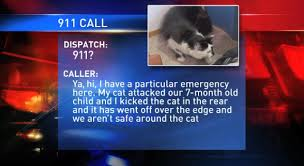
A cat named Lux made headlines when he went on a rampage and trapped his family in their bedroom, fearful for their lives. When the family called 911, telling police the 22-lb Himalayan was out for blood, the incident went viral.
The story reached the ears of celebrity cat behaviorist Jackson Galaxy who jumped in his pink ’57 Lincoln and hotfooted it to Portland. In normal circumstances, a violent cat such as Lux would be euthanized; Galaxy didn’t want to see that happen and decided to feature Lux on his popular television show, “My Cat From Hell.”

Once Galaxy took charge, Lux (who turned out to be a domestic longhair tuxedo cat of a mere 14-pounds) disappeared from the media. Only a few people knew what the eccentric behaviorist was up to. I was one of those.
I took Lux into my home and heart, but it wasn’t an easy ride. The next few months brought laughter and tears, pride and humility, love and terror and more.
In the beginning, I was, to put it bluntly, arrogant. I believed that with all my vast cat experience, I could tame this tiger. For a few weeks of pure furry bliss, I thought I’d succeeded. But you know what they say about pride.

Out of the blue, Lux had another outburst. It was just as terrifying as his family had described and sent me to the ER with deep gouges across my leg. (The scars remain today.) Lux’s violent behavior continued, and suddenly I had a monster in my house. The fact that the whole thing was being filmed for national television only made things worse.
Due to Animal Planet legalities, an in-depth account of Lux’s story has never been issued, but I kept a personal journal which I published on my blog. “Pet the Tiger” follows the convoluted and heart-wrenching tale of love and loss and love again. This is how it begins:
When I was a child, I thought I could run with the tigers. I had no fear; I knew they would not harm me. Then I grew up. My conviction faltered, and like the fairies in Peter Pan, without belief, faded into the dullness of adulthood. Still, when I saw the big dangerous cats in all their feline glory, I couldn’t help wanting to touch them, pet them, feel their fur. I wanted to hug them, hold them, bury my face in their solace of stripes.
I felt the same thing the first time I saw Lux. The photo of him in the MCAS cattery girl’s arms – I wanted to be that girl, to hold that big kitty myself. The fact he was considered dangerous just made me want to hold him more. After all, he didn’t look dangerous; he looked like a poor sad kitty who needed my love.
Continue reading this 34-part saga and the following updates HERE.

Portland’s notorious 911 cat Lux went to his forever home in December of 2018. What has our boy been doing for the past years? Well, basically, he’s been acting like a normal cat. For wonderful photos of him in his home habitat, click HERE.

April 10, 2024
Announcing the Surrender Prevention Workshop by Dr. Rachel Geller
Okay, maybe not the entire world, but the part of it that is home to feral and community cats.
Dr. Rachel Geller is a certified Cat Behavior and Retention Specialist, an author, and President of All Cats All the Time, Inc., a 501c3 nonprofit dedicated to promoting the adoption of cats and preventing their surrender through free-of-charge cat behavior counseling. Dr. Rachel is now dedicating her time and energy to teaching others the steps to being a functioning advocate for community cats through her Surrender Prevention Workshop.

The headline reads: Be the difference between a cat losing her home and staying in her home. Doesn’t that sound like a worthwhile pursuit for any compassionate person? Are you ready to help community cats in your neighborhood in a meaningful, effective way?
Learn more, watch a TNR video, or sign up for Dr. Geller’s important and instructive workshops here.
About the Surrender Prevention Workshop:
Join this session to learn what surrender prevention is and why it works. Instructed by Dr. Rachel Geller, she will share real examples, with proven results, setting the potential surrenderer and cat on the road to a happy relationship together and keeping the cat in her home. We’ll cover how to empathize with cat owners, working around their limitations (financial, time, patience) and focus on the 3 most common reasons for surrender: litter box problems, scratching (and not on the scratching post!), and inter-cat aggression. Take advantage of the interactive format, extensive handouts, and video footage of actual techniques. Attendees will receive a certificate after taking a short quiz. The workshop will be offered four times in 2024.
April 7, 2024
NEW STORIES FROM AN OLD SOURCE

I’ve been clearing out my files lately, going through and tossing things that are no longer relevant to me and my life. I have a tendency to keep everything—every scrap of paper, every event program or ticket stub; every submission entry that got rebuffed. In my look down file cabinet memory lane, I found newspaper clippings from when there were newspapers. I found printouts from internet searches because loading used to be so slow I printed anything I thought I might want to read again. I also turned up a whole drawer full of rejection slips from manuscript queries to publishers and agents. At one point they were relevant but not any more, so I tossed them.
Not everything in my old file cabinet was rubbish, however. One bright orange folder labeled “New Stories” turned out to be a lot of fun.
Writers come up with story ideas all the time, and when I first got into writing as a full time thing, I jotted down every little thought. Some turned into stories, some turned into books, and many got put away in this folder for later. Now it’s much much later, and many of these keepsakes I’d totally forgotten.

The first thing I see is not a page but a photograph of a quaking aspen we encountered on a trip through the Grand Canyon. One morning, I came up with a story that I told out loud, about a pair of crows who lived in the aspens, about how they became trees, or maybe it was the trees who became birds. Since I didn’t write it down, I’m not sure. Whichever it was originally, it later became the inspiration for a sequence in my sci-fantasy Cat Autumn where Niva space-shifts and becomes a tree.

The next are typed and stapled pages from even longer ago when I took a creative writing class at PCC. These go back to before I was writing books. The comments from the teacher are revealing.
A little later in my writing career I became interested in short fiction and flash fiction. One named “Shoot the president!” jumps out at me. A Nixon-era flashback, it has resonance when I wrote it in 2017.

Next page: The Four Noble Truths
Then dreams.
Then a quote from one of my favorite books, Gormenghast, by Mervin Peake.
There are a lot of lamentations about anxiety—too many.
A cast list for a book I never published.
A note about that time when I was working for UPS and went to an apartment that smelled like rotting flesh. Ewww…
A newspaper clipping: Hawking reverses his controversial black hole theory, 2004.
A story idea about a serial killer who displays the murder weapon in the window of his room.
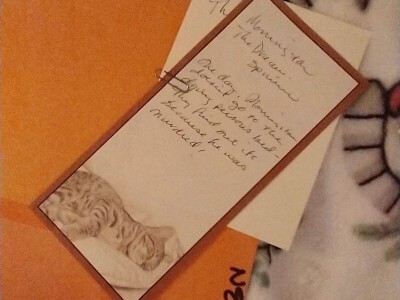
The very first notes for my published short story, The Dream Spinner.
Will anything come out of my rediscovery of these old story ideas? Your guess is as good as mine.
April 2, 2024
COMING SOON, ANOTHER GHOST CAT COZY ADVENTURE!
 Ghost Cat at the Mystery Hotel
, the 3rd instalment of my Tenth Life Paranormal Cozy Series, is on its way!
Ghost Cat at the Mystery Hotel
, the 3rd instalment of my Tenth Life Paranormal Cozy Series, is on its way!Today I’m beginning one of the last steps before Ghost Cat at the Mystery Hotel, the 3rd instalment of my Tenth Life Paranormal Cozy Series, is ready for release—reading through the proof copy for a final edit. Then once my editor and I are happy with the results, the magic happens, and the book goes live.
We’ve got a tentative launch day of May 30th, and the eBook preorder link is up HERE. The paperback version will also be available for purchase on May 30th.

Here is the wonderful new cover design by Roslyn N McFarland.
The game is murder at the Mystery Beach Hotel.
When Camelia Collins meets her old college friend Anne Pine for a murder mystery weekend at the coast, death becomes more than a game.
Accompanied by her ghost cat companion Soji, Camelia begins to discover clues that aren’t part of the role-playing storyline. A lurking stranger spies on Camelia from the house next door. A vengeful spirit haunts the hotel. A winter storm rages outside, threatening the old building, while a murderer roams the halls, threatening those within.
Will Camelia’s keen senses and Soji’s feline wiles be enough to catch the killer before they kill again?
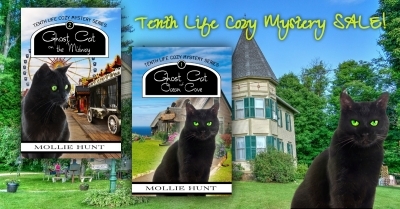
Get ready for a new Tenth Life adventure by catching up on the first two books of the series. To celebrate, paperback versions of Ghost Cat of Ocean Cove and Ghost Cat on the Midway are on sale now through May 30th when you purchase them directly from me. It’s $12 for one book and $20 for two. (includes Media Mail shipping – USA Addresses only) Email your choices to molliehuntcatwriter@gmail.com with Ghost Cat Sale in the comment line.
Ghost Cat of Ocean Cove, a Tenth Life Cozy Mystery 1
A ghost cat and a cold case murder turn a septuagenarian’s beach house dream into a nightmare.
Ghost Cat on the Midway, a Tenth Life Cozy Mystery 2
When the keeper of an aging tiger is murdered at the Cove County Fair and the tiger goes missing, ghost cat Soji must make sure Camelia isn’t the next to die.
March 29, 2024
TYLER, A CAT OF MANY BIRTHDATES
 First birthdate: May 12, 1999
First birthdate: May 12, 1999When I adopted Tyler from the Oregon Humane Society in 2017, he was listed as being 18 years old. A stray who had been living on the streets for an untold amount of time, Tyler required some care after a good Samaritan brought him in to the shelter. This included a complete dental extraction because his teeth were so bad. Teeth are often a gage of a cat’s age, and before the extraction, the OHS doctors assessed him to be quite senior. They gave him a tentative birthdate of May 12, 1999—May 12 for the date he was relinquished to OHS, and 1999 as an educated guess of a year born. How could I leave an 18-year-old cat in the shelter when I had room at my home?

Birthdate #2: June 2, 2003
Shortly after I adopted Tyler, I took him to my vet for his initial visit. My doctor was amazed at Tyler’s good health! Despite being underweight and having a chronic non-progressive eye condition, his lab work was amazingly normal with no sign of kidney disease or any of the other issues an older cat can have. He ran and played like a kitten, so no arthritis either. With no teeth to look at for clues to his age, Dr. Leon thought him to be closer to 14 and revised his birthday to June 2, 2003.

A few years ago, I changed vets to the one I have now for both Clarence and Tyler. I don’t know why my new clinic decided to revise Tyler’s date of birth to 01/01/2004, but that’s what they have on record and that’s what I will stick to, unless someone can come up with a better idea. Since Tyler’s had a full Basepaws DNA panel run, I imagine only a cat psychic could furnish a more accurate date.

Tyler may not be running as fast or jumping as high as he did seven years ago, but he’s still going strong. His good health has continued so far, and after his next bi-yearly wellness check in April, we will be able to see if anything has changed. The Basepaws DNA profile was done for a study on longevity in cats, and they said he was a perfect specimen. But to me, he’s just wonderful Tyler, the love of our lives, as we grow older too.
Read the award-winning poem I wrote when I first adopted Tyler HERE:
March 16, 2024
COZY MYSTERIES: THE CAREFUL ART OF NOT TELLING ALL
Of course you want to guess the killer, but how soon do you want that to happen? How obvious should it be?
How convoluted a tale do you like to follow? Should it be complex like the old Inspector Morse series or simple like Murder She Wrote?
Do you like character-based or plot-based stories?
What is your idea of the perfect cozy mystery?

Photo by David Lezcano on Unsplash
I am about to launch one cozy mystery while working on the first draft of another, and my mind is filled with questions. For the one being published, Ghost Cat at the Mystery Hotel, the third book in the Tenth Life Paranormal Mystery series, I wonder if readers will like it? Did I (and my team of beta readers) miss any plot holes? What will I write next? For the draft of the eleventh Crazy Cat Lady Mystery (I have yet to settle on a name) I have even more questions, such as who will the killer turn out to be and what red herring should I add to keep the reader from guessing right off? But there are other questions as well, ones that go deeper into the process of the story itself. Here are just a few.

Photo by David Lezcano on Unsplash
How cozy is cozy?Writing in the cozy mystery genre comes with a lot of rules. There should be no excessive cruelty or graphic violence, no profanities or exclamations using the Lord’s name, no explicit sexual activity or “adult” situations. In my two cozy mystery series, I obey most all the rules, but I’ve read a lot of cozies that push the envelope a little—or a lot.
We won’t kill an animal in cozies, but humans kick the bucket all the time. It wouldn’t be a mystery without at least one dead (human) body. But as to how they meet their demise, there are many ways. Should all deaths occur offstage for some unsuspecting innocent or amateur sleuth to discover, or can we actually witness the dirty deed once in a while?
What do you think about a bit of swearing? Is dammit okay? Is damn? What about even more cursey curse words? Can you overlook a few of them for the sake of the story as with Louise Penny’s Ruth in the Gamache Series?
If there is a romance between consenting adults, how far can it go? Can there be, if not an actual bedroom scene, an allusion to one, or must all affairs be chaste until marriage?

Photo by Sixteen Miles Out on Unsplash
Do the Cozy Rules go far enough?You won’t find one of my characters forcing unwanted sexual attentions on someone else, but there are books that call themselves cozy where that storyline does play a part. Would you want to know ahead of time that the plot may involve rape or attempted rape?
What about suicide? For those whose loved ones have taken or tried to take their own lives, the subject can instantly destroy their enjoyment of a story. Would the mention of it be acceptable, whereas incorporating the actual death as a crucial plot point might be too much?

Photo by freestocks on Unsplash
Trigger warnings: What do you want to know?Warnings alerting readers that a story contains potentially distressing material have become widespread. These warnings, often an actual statement at the beginning of the book, but may also be incorporated in the blurb description, are a way for readers to make an informed decision whether to read the book or not. By its very nature, a cozy shouldn’t need a trigger warning, but depending on what the story entails, it could be a way of softening the blow when some cozy rules are broken.

Photo by Chelsea Coye on Unsplash
So… a lot of questions. Drop an answer in the comments if you are so inspired. Or email me directly at molliehuntcatwriter@gmail.com. I’d love to hear what you think.
March 4, 2024
Reblogging: Animal Charities and Welfare Groups Express Concerns for Cat Wellbeing in Hollywood Movie ‘Argylle’
Unfortunately, movie audiences are influenced to emulate behavior they see on the screen. We cat people need to fight back with facts. Here are some:
Source: Animal Charities and Welfare Groups Express Concerns for Cat Wellbeing in Hollywood Movie ‘Argylle’
March 2, 2024
SECRETS TO SUCCESSFUL (FELINE) FICTION, Part 2

A few days ago in my blogpost SECRETS TO SUCCESSFUL (FELINE) FICTION, Part 1, I posted a list of questions posed to me and my fellow fiction panelists at two Cat Writers’ Association Conferences. Now, here are the answers. Note, these are my opinion from my own experiences as a fiction writer in multiple genres. They may not be the same as yours since we all travel our own writing road, but I’m hoping these tips may still be helpful.
SECRETS TO SUCCESSFUL FELINE FICTION: My ResponsesFiction has many genres and subgenres. Some writers write across two or more genres.
Popular Fiction Genres: Fantasy, Science Fiction, Adventure, Romance, Crime & Mystery, Horror, Thriller, LGBTQ+, Historical Fiction, as well as Young Adult and Children’s fiction. There are also an unlimited number of sub-genres and cross-genres.
Where do ideas come from?They come from everywhere, both imagination and reality.
Tip: Some writers use prompts to get their ideas flowing. There are many prompt lists on the internet, or just look around you, your room, your house, outside your window. Also dreams, fantasies and things we see on TV can be places to begin a story all your own.
Write what you know—or don’t?Yes, but you know a lot.
Tip: It’s not always the big things that make your story believable. You may not know what it’s like to be a superman in flight, but you do know the feeling of the wind against your face.
Creating realistic cat characters. Are they based on your own cats?Some yes and some no.
Tip: Including your cat in your book can be bittersweet since your book will most likely outlive your cat.
How do you create realistic dialogue?By listening.
Tip: Take note of people’s conversation, then remove most of their automatic uh’s, so’s, and yeah’s. For a useful look at how dialog works, turn on your television’s closed captioning feature and read along.
That pesky first draft, and other stages of fiction writing.Start, keep going, end.
Note: There are several steps to maneuvering a raw idea to a published book. A first draft is the fun part where you let your imagination flow. This rough initial telling of the story from beginning to end is bound to change and evolve in subsequent revisions.
Tip: Don’t worry about it. Keep the first draft flowing ahead, despite the urge to go back and do major edits. Those come later.
A daily writing process?Developing a consistent writing practice is key to being a successful writer.
Tip: Choose a time that works for you—be it 5:00am before work, 9:00 pm after the kids go to bed, or something else—and stick to it. Some authors only write on weekends or at retreats.
How, and why, to create a believable Backstory.Write it out, for your eyes only.
Tip: Backstories help the author know their characters and settings so they can fully describe them to the reader. Many authors write down entire histories; others make a list of points. Most of the time, only a small part of this matter should actually make it onto the page.
Writing a series?Writing a series is a different process than developing a single story.
Tip: Make setting and character lists, notes, spreadsheets, anything to keep your story consistent from book 1 to 10 and beyond. Don’t get bogged down in what happened in a previous book, and never give away a previous ending.
Never kill the cat, and the times you can break the rule.It depends on the genre, but most readers will be put off by an animal death, and many will stop reading, never to pick up another book by you in their lifetime.
Tip: Think before you take this step. Consider a scenario where the animal is thought dead but is only missing. An old animal may pass on gently if it’s integral to the plot.
Avoiding info-dumps.“Show, don’t tell.”
Note: An info-dump is a big block of storyline facts given as an explanation, description, or backstory. Info-dumps can be a good way for the writer to lay out their, but that information should then be presented to the reader in a more interactive form
Can people learn something from reading your books?Yes, but don’t be preachy or teachy.
Tip: I like fiction that teaches as well as entertains. Including a little-known fact or the meaning of a new word can stimulate a reader’s interest.
When is that book really finished?If you don’t know, ask your editor.
Tip: It’s hard to put down that pen and call a book done. In fiction, there is usually a wrap-up of some kind, explaining all the little details not already covered, but some authors cut or condense their entire last chapter. A good example are Sue Grafton’s Kinsey Millhone Alphabet Series.
Three additional questions that came from a reader:
– Which genres or sub-genres do you think are under-represented under the larger umbrella of cat fiction?
I’m not sure it works like that. The farther your story gets from your base genre (one of the 12 listed above) the smaller your audience will be. But that shouldn’t stop you or sway your story. Many of my cozy cat readers aren’t interested in my cat sci-fi, but some who would not normally read sci-fantasy, have tried it (and liked it!) because there are cats. Bottom line, write your story and don’t worry about who might read it or where it might fit in the genre hierarchy.
– Do you think there’s an audience for somewhat hard SF involving cats?
Absolutely. The Tale of the Barque Cats books by Anne McCaffrey and Elizabeth Ann Scarborough come to mind.
—Do you think people who are generally interested in cat fiction would also be interested in stories that have big cats as major characters?
I’d read it.
The Bonus question, what is a cozy mystery?The term, “cozy,” became popular in the late 20th century, describing a style of writing similar to Agatha Christie and Mary Stewart. These mysteries, gentler than a hardboiled crime drama, are a puzzle to be solved. The hero, an amateur sleuth who has somehow been drawn into a crime such as murder, must find the solution, and it’s the reader’s job to try to get there first.
Cozy mysteries are character-driven (as opposed to plot-driven). They steer away from horror and violence, allowing those things to happen off the page. There is no sex or foul language. This lack of overt violence, profanity, and sex helps to make these stories, while exciting, somewhat relaxing as well. Oh, and did I mention the prerequisite happy ending? These things are a draw to many 21st century readers, including myself.

For more resources and information about cat writing and writers, visit the Cat Writers’ Association.
February 27, 2024
SECRETS TO SUCCESSFUL (FELINE) FICTION, Part 1

As a grateful member of the Cat Writers’ Association, I’ve had the pleasure of working with some amazing fiction authors. In two panels in which I participated, several questions came up multiple times. I’ve presented these questions here, and in a my next post, I will try to answer them.
But first, what is fiction?Fiction is usually described as something that isn’t true, an imaginary scenario. Fiction almost always has some basis in fact, but the story and characters are made up by the author. The Cambridge Dictionary defines it as: a book or story that is written about imaginary characters and events and not based on real people and facts.
Fiction has many genres and subgenres. Some writers write across two or more genres.
Popular Fiction Genres: Fantasy, Science Fiction, Adventure, Romance, Crime & Mystery, Horror, Thriller, LGBTQ+, Historical Fiction, as well as Young Adult and Children’s fiction. There are also an unlimited number of sub-genres and cross-genres.
SECRETS TO SUCCESSFUL FELINE FICTION: The QuestionsQuestions asked of the panel at the St. Louis CWA Conference 2109 and the Online Conference 2022. Panelists included fiction authors Debbie De Louise, Patricia Fry, Mollie Hunt, and Sandra Murphy,
Where do ideas come from? Write what you know—or don’t?Creating realistic characters, including cats. How do you make the cats in your fiction realistic? Are they based on your own cats?Do you write from the feline POV, or does another character “narrate” your cat character’s actions? Do the cats in your books talk, or are they silent except for cat sounds?How do you create realistic dialogue?That pesky first draft, and other stages of fiction writing. (Revisions, edits, etc.)A daily writing process. Plotting vs. Discovery Writing (Pantsers)How to create a believable Backstory.How do you edit your books? Read them out loud to your cats? Listen to a “Read Aloud” feature on your computer? Beta Readers, Editors, & Self-Editing.Tips on writing a series: Coming up with a unique new theme, which is a different process than developing a single story. Setting and character lists. Do’s and don’ts, such as don’t give away what happened in the previous book. If you write more than one cat series, how do you make them unique?Never kill the cat, and the times you can break the rule.Red herrings, MacGuffins and twists.Avoiding info-dumps.Research: Facts in fiction—even fiction must be factual in essence. Can people learn something from reading your books?What is world-building? How do you use description, character, environment, and situation to create a fictional world?When is that book really finished?Bonus question: What the heck is a cozy mystery anyway?

Answers, from my point of view, will be coming soon. Meanwhile, if you have any more questions, please feel free to add them to the list.
February 14, 2024
HOW OLD IS TOO OLD TO ADOPT A CAT?

Photo by Julia Zyablova on Unsplash
There are various reasons not to adopt a pet, but age shouldn’t be one of them.I talk often about the advantages of adopting a senior cat. How they won’t climb your curtains or bite your toes. How they may be more prone to sitting curled quietly in your lap or next to you on the couch. In other words, how a senior cat has learned how to be a perfect companion. This time, I’m not referring to the cat’s age, but to our own. Should people who are getting on in age take on the responsibility of a kitten or cat?
If that’s what they want, of course they should!
I recently adopted a 7-month-old kitten. I am seventy-one. I hadn’t intended to choose a younger cat, preferring the old ones for the reasons listed above plus the fact they are often overlooked in shelters, but stuff happened. Little Clarence joined our family after we lost my sweet Jaimz and the surviving cat was lonely. I never gave my age a second thought when I signed the papers, but others did.
I received an unexpected reaction from more than one friend. Instead of the anticipated congratulations, they questioned why I wasn’t worried that Clarence would outlive me. I was taken aback. I did some quick math. Since cats are living up to and beyond their twenties, that would make me ninety-one. Suddenly I saw where my friends were coming from. What are the chances I will make it to that age, and if I do, will I still be able to clean the litter box? Will I still be able to remember poor kitty’s name?
Arg! That question really got to me. I had to work it out in a way that made sense. Reluctantly I found myself rethinking the commitment I’d taken on when I adopted this lovely, three-legged kitten. Were my friends right? Was I just plain too old to have a cat?
The idea of living without feline company felt heartbreaking, but the people who offered me this shocking conundrum had a point. Adoption is a responsibility, for now and for the rest of that cat’s life. What was I going to do to make sure Clarence would be cared for if I could no longer care for him myself?
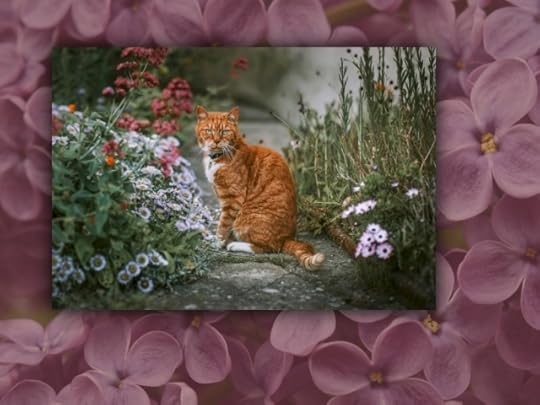
Photo by Zoltan Tasi on Unsplash
Here is what I came up with:Make arrangements and put them in writing.Making arrangements for my cats in the event of my death was something I’d already done, naming a pet guardian along with designating a bequest for care in my living trust. It is a family member with whom I sat down and discussed the matter, making sure they were willing and able to follow through with the promise.
Consider your cats when making housing choices.*Remember, wills and trusts need to be updated every so often. If for some reason the potential guardian becomes unwilling or unable to fulfil the duty, I will need to revise my trust.
As it stands, my husband and I are happy in our big Victorian house, but there may come a time when the place becomes overwhelming. We may need to move into somewhere easier to maintain, or even into assisted living. It’s a good idea to look around at facilities before crunch time and to become familiar with what the move might entail.
When looking into future housing, make sure to keep cats in mind, because they are not welcome everywhere. If assisted living is needed, find out who will help care for your cats if the necessity arises.
Stay healthy, live longer.The world is a tough place right now, whether you’re suffering yourself or just watching others suffer in the news. Grab your cats and give them a hug, because it’s a proven fact that cat companions keep you active and alert, as well as lowering your blood pressure with their loving purr. Eat healthily, take walks, and do everything possible to reduce stress, just like your doctor tells you. If you have trouble getting motivated to do it for yourself, then do it for your cat who needs you.
Keep your cat healthy.A healthy cat is easier to care for, as well as being less expensive to maintain. Cut out surprise trips to the Emergency vet by taking care of your cat on a regular basis. See my blogpost 10 Ways to Help Avoid a Cat Health Emergency for a few tips.
Cultivate and advocate or two.It’s hard to ask for help, but it’s something we have to do sometimes. Friends and family want you to be happy and will often come to assist when they can. Do you need someone to drive you and your cat to the vet for an appointment? Can someone pick up cat supplies for you while they’re out running other errands? Cat shelters also may have volunteers who can help. The burden of your cat’s care doesn’t have to rest solely on you.
*If you haven’t already tried having cat supplies shipped directly to you, look into it. I use Chewy, which delivers to my door free on orders over $49.00. There are varied reviews, but I’ve personally had a good relationship with them.
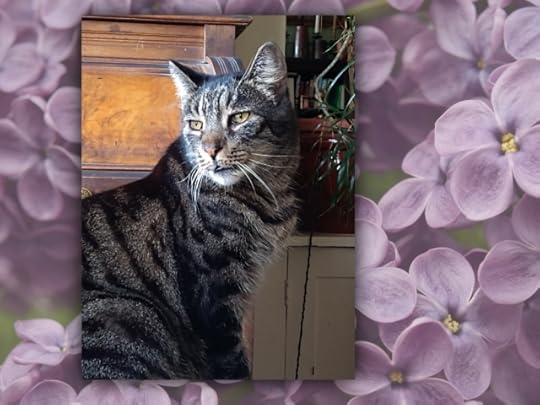
Tyler
Your cat and you: the purr-fect relationship at any age.Remember that cat companions provide important forms of social and emotional support for older people. Their companionship reduces distress, depression, and loneliness plus increases self-esteem and improves overall quality of life. So don’t write off getting that new furry family member just because you’ve had a few dozen birthdays. With thought and planning, both you and your cat can thrive.



